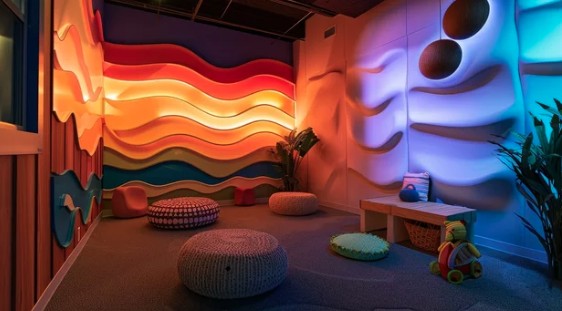
By Corinne Grossman, OTR
In recent years, a captivating design trend has been gaining traction across homes, schools, hospitals, workplaces, and even airports: sensory rooms. These multi-sensory spaces are designed to provide a sometimes calming, sometimes energizing, but always therapeutic environment that helps the nervous system to regulate. The beauty of sensory room design lies is its flexibility. Designers blend natural elements such as wood, stone, and soft fabrics with high-tech features, like mood lighting, calming soundscapes, and interactive devices. Color plays a crucial role—soothing blues and greens are often favored for their calming effects, and the use of tactile elements like squishy cushions or textured walls may engage the sense of touch. The goal is to create a space that is both functional and therapeutic, where every element contributes to the overall experience.
What exactly makes Sensory Rooms so popular, and why are designers increasingly incorporating them into their projects?
In our fast-paced, hyper-connected world, sensory overload is common. Constant exposure to screens, noise, and bright lights can leave us feeling stressed or anxious. Sensory rooms provide a retreat space where lighting, textures, colors, sounds, and scents are carefully curated to create a soothing atmosphere. Whether it’s for relaxation, focus, or emotional regulation, these rooms are often designed to offer a moment of calm.
While sensory rooms may originally have been designed for children, particularly those with special needs including sensory processing disorders, autism spectrum disorder (ASD), and those dealing with anxiety and stress, their versatility has led to a rise in popularity across various sectors. Schools and daycare centers are incorporating sensory spaces to help children focus and manage stress. Corporate environments are creating sensory rooms that provide employees with a break from their workstations to recharge and improve mental clarity. At home, people are embracing these spaces as personalized retreats to unwind from the daily grind and to meet the sensory needs of family members.
Conclusion
As the world continues to place a greater emphasis on mental health and well-being, sensory rooms are more than just a trend—they are becoming an essential part of thoughtful interior design. Whether creating a tranquil environment for relaxation or offering a therapeutic tool for those with specific needs, these rooms are a perfect example of how design can support and enhance human experiences. As this movement grows, expect to see even more innovative sensory spaces that cater to the unique needs of individuals in diverse settings.
About the Author:

Corinne Grossman, OTR is an Accredited Occupational Therapist with and Founder of Sensory Space Designs. Her company provides custom therapeutic environment consultation to empower individuals through inclusive sensory room design.
